

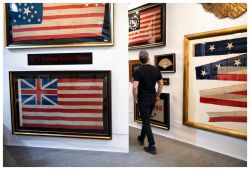
Here’s what to know for a last-minute getaway to the spring show — perfect for anyone who appreciates unique decor, furniture and art.
“…Round Top’s antique shows are actually spread out between a half dozen towns, including Round Top, Carmine and Warrenton. Between stretches of farm land are separate venues that are housed in barns, outdoor stalls, tents and indoor halls. Make sure Market Hill, Marburger Farm Antique Show, the Big Red Barn, The Halles, Blue Hills, The Arbors and the Warrenton fields are on your list. Each venue boasts a roster of vendors specializing in high-end imported antiques and one-of-a-kind finds.”
At the Big Red Barn, stop by Jeff R. Bridgman American Antiques, showcasing patriotic textiles, rare flags and banners, among other items. Chad is eyeing an early 20th-century flag for a Dallas client’s lounge.
https://www.dallasnews.com/abode/2023/03/27/dallas-designer-chad-dorseys-insider-tips-for-the-round-top-antique-fair/
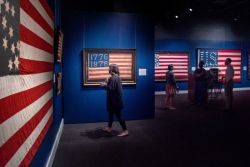
An exhibition of historic flags and documents brings the nation's often-contentious and violent history into view in time for the high days of the patriotic season.
The tattered 13-star flag that welcomes visitors to the Museum of the American Revolution’s new special exhibit, “Flags and Founding Documents, 1776-Today,” evokes the smell of gunpowder, the whistle and thud of musket balls, and the threadbare birth of a scrappy new nation.
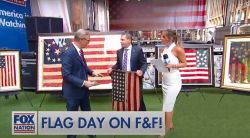
[Or click here to watch the segment: https://www.dropbox.com/s/eudj817k8hnedve/Watch%20Fox%20and%20Friends%20After%20the%20Show%20Show_%20Season%202%2C%20Episode%20119%2C%20_Friday%2C%20June%2014_%20Online%20-%20Fox%20Nation%20-%20Google%20Chrome%206_14_2019%203_09_10%20PM.mp4?dl=0]
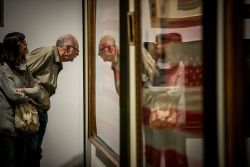
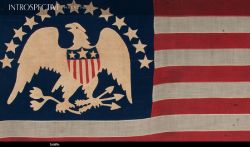
It's well-known that many early American flags had 13 stars, representing the 13 colonies that declared independence from Great Britain in 1776. Less well-known is that the United States never mandated a design for those flags. That's what makes a new show at the Museum of the American Revolution, in Philadelphia, so compelling...
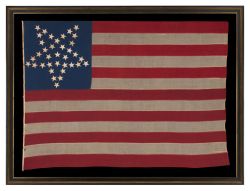
Expert Jeff Bridgman explains the history and meaning behind the twinkling constellations that have graced Old Glory.
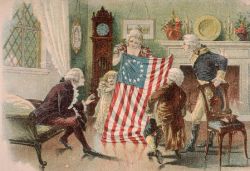
Jeff Bridgman is quoted in TIME Magazine concerning Nike, Colin Kaepernick, and the 4th of July Release of the 13 Star Flag Shoe
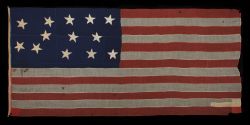
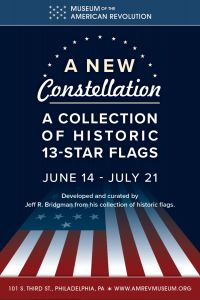
Forty Historic 13-Star Flags to be Displayed Together for the First Time Beginning Flag Day, June 14 – July 14:
This Flag Day, 40 historic 13-star flags will go on display at the Museum of the American Revolution in Philadelphia, marking the first time that a major exhibit of flags in this star count has ever been undertaken. Most of the these have never been previously displayed anywhere, let alone together. The exhibit, "A New Constellation: A Collection of Historic 13-Star Flags," will be on view from Flag Day, Friday, June 14 through Sunday, July 14, 2019...
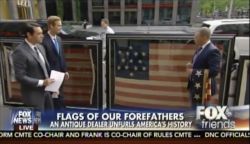

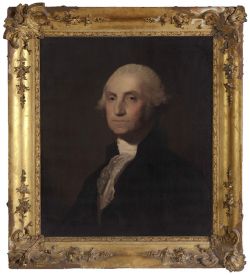
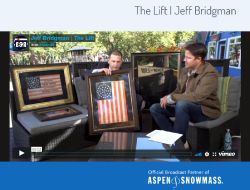
Click here to watch the segment: https://aspen82.com/the-lift/lift-jeff-bridgman/

See one of Jeff Bridgman's flag among early Navaho textiles, when you visit the White House Tavern in Aspen, Colorado. Be sure to get a bite to eat while you are there. We can tell you first hand that this establishment never disappoints!
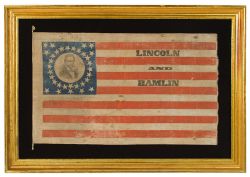

Article by Caroline Collins McKenzie, Photos by Paul Costello, Styling by Sarah Cave
Be sure to watch the BBC's fantastic new documentary on the history of America and American art. Jeff Bridgman is featured about three-quarters of the way through the one hour program, which you will find especially difficult to turn off. It's difficult to describe what a fantastic job host Andrew Graham Dixon and his cinematographers do with the topic. Enjoy!


Jeff Bridgman, a Pennsylvania-based folk art dealer who brought to the show a circa 1915 carousel horse, said partnering with 1stdibs is a way to "introduce folk art to a younger audience," one that has shifted "towards modernism and away from Americana" in recent years. The recession and popularity of midcentury, he added, has advantages for new folk art collectors looking for deals. "This isn't the worst time in the world to buy," Mr. Bridgman said.
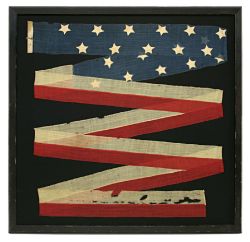
Much of what we believe about the American flag and its history is not true, or so claims Jeff Bridgman, an antiques dealer in the rural Pennsylvania town of Dillsburg, near Gettysburg, who specializes in vintage examples of Old Glory. He says, for example, that Betsy Ross probably did not create the first American flag, and that Francis Hopkinson, a New Jersey signer of the Declaration of Independence, is a likelier candidate because in 1780 he billed the government for designing the flag and other patriotic emblems...
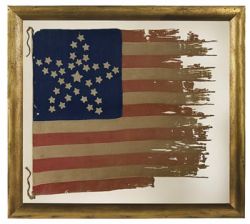
ASPEN — Since 1998, Jeff Bridgman has been learning about a unique niche in American history one stitch at a time.
The antique dealer who specializes in Americana and folk art was captivated when he saw two antique, hand-sewn American flags at a show 13 years ago. Their beauty and the history behind them opened a world that he hadn't explored before.
"I was blown away by the fact that I didn't understand about these things," Bridgman said. "I thought 'if there are more of these, why aren't people buying them for art and history?'"
Three weeks later he purchased his first early flag. Since then he has immersed himself in buying and selling the Stars & Stripes — and sharing the stories of the roughly 1,000 flags he has in stock at any one time.
Bridgman, who is based in Pennsylvania, is displaying some of his coolest flags July 1-10 at the Aspen Antiques & Fine Arts Fair at the Aspen Ice Garden. A centerpiece of his Aspen display is a torn and frayed beauty. It has 34 stars arranged in the "Great Star" pattern — where the smaller stars form a larger star. One star larger than the other 33 is the centerpiece. The flag was entirely hand-sewn and made of cotton. It came from upstate New York in Oswego County and was handed down among generations of two families. The word among the families has always been that it was made by women of the area when a local, volunteer unit marched off to fight in the Civil War.
It's rare that flags like that were saved through the decades. "Most of them get tossed," Bridgman said.
Before the Civil War, the national flag was used sparingly, Bridgman said. Troops in the Revolutionary War and War of 1812 weren't authorized to carry the Stars & Stripes.
They were more likely to carry the federal standard flag and a regimental flag.
The images of George Washington marching in battle with the American flag is "sort-of a myth," he said. "He may have carried it on occassion, but it was not customary. The regular inclusion of the Stars & Stripes in colonial and Revolutionary War images is inaccurate and terribly misleading."
The military shifted gears in the Mexican-American War and started carrying the Stars & Stripes. And during the Civil War, it was almost guaranteed that the women of townships would get together and sew a flag for the boys going off to war.
The great thing about early American flags is there were so few rules beyond the red and white stripes and the blue canton. The star pattern was open to the creators' imaginations. (The standard pattern was legislated in 1912 with 48 stars after Arizona became a state, with alterations made for Alaska and Hawaii.)
Bridgman views flags of the 18th, 19th and early 20th century among the greatest creations of American folk art because there are so many interesting star configurations, often home made.
The 34-star flag in the Great Star pattern was produced between the time Kansas was admitted to the union at the 34th state on Jan. 29, 1861 until West Virginia was added as the 35th state in June 1863.
Bridgman calls the Civil War-era Great Star flag the "Rolls-Royce" of designs. It's both rare and desirable among collectors. He said the tattered flag is no detriment. It reflects the flag's use outdoors and, possibly, in battle.
Bridgman is asking $34,500 for the flag. He figures the type and amount of damage adds roughly $10,000 to the price.
His website, www.JeffBridgman.com, makes it clear that the best antique flags don't come cheap.
"If you are a bargain shopper, I must warn you that you have come to the wrong place," the website says. "But if you are looking for extraordinary form, outstanding surface, early condition, and confidence in authenticity, you have arrived at a destination that I encourage you to consider."
Bridgman said the recession didn't hurt the antique flat business. Overall numbers were down during the heart of the recession, he said, but values continued to climb.
"It's something about flags that makes it different," he said. "It's more like Corvettes and guns."
He brought at least 125 flags to the Aspen Antiques and Fine Arts Fair. He estimated 30 to 40 are from the Civil War era.
He also has around 20 styles of the 38-star flag that reflect Colorado's statehood in 1876. He naturally brought several of the Centennial flags to the Aspen show because they are popular with full-time Colorado residents and second homeowners.
Bridgman focuses on flags made prior to 1880. "After 1879, it became a lot more generic," he said.
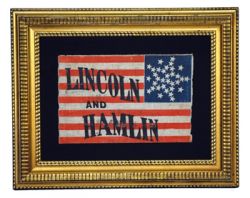
Morris Offit loves watching people enter the offices of his New York wealth-management firm, Offit Capital Advisors, which is filled with antique American flags. "People are overwhelmed," he says. The flags get people talking—and, in some cases, buying their own.
Mr. Offit took up his hobby in 2004 when he accompanied his wife, Nancy, on one of her regular prowls through an antiques show. A small antique flag at the booth of Jeff R. Bridgman caught his eye, and Mrs. Offit encouraged him to buy it. Before long, he'd made friends with Mr. Bridgman, a York County, Pa., dealer who specializes in "early American Stars and Stripes," and a collection was born.
Now, the 74-year-old Mr. Offit owns 40 to 50 flags and other historical textiles, including one of the earliest known kerchiefs depicting George Washington. Among his favorites: an 1876 flag from the U.S. centennial celebrations that hangs in his office.
In the realm of antiques, historical American flags and political textiles form a small category, but one with truly passionate collectors. The rare pieces dated before the 1820s fetch the highest prices. In 2006, Sotheby's set the record when it sold a Revolutionary War cavalry flag for $12.33 million, well over its $3.5 million high estimate. In the same sale, the same buyer, who has remained anonymous, purchased three additional Revolutionary War battle flags for $5.05 million.
Mr. Offit says such purchases are beyond his flag budget. This pastime "has all to do with decoration, history and patriotism. It's a good warm feeling to collect American flags," he says.
Owning a piece of history is one of the common feelings that drives flag collectors, says David N. Redden, a Sotheby's vice chairman who handles flags. The very best specimens, he says, "are magical objects, combined with an incredibly rich story." Many designs are also beautiful, he adds. Mr. Offit says it's the design that attracts him. "What most people don't realize," he says, "is that before 1912, there was no official configuration" of the U.S. flag. "So there were flags with medallions and great star patterns."
In 1777, Congress decreed: "Resolved that the flag of the United States be 13 stripes alternate red and white, that the union be 13 stars white in a blue field representing a new constellation." In 1818, Congress set the number of stripes as 13, but let the stars grow with each state.
President William Howard Taft determined to set an official arrangement, and people vied to be the designer. Wayne Whipple of Philadelphia devised a configuration placing 13 stars, for the original colonies, at the center arranged in a six-point star, which is surrounded by a circle of 25 stars representing the states that had joined the Union by the centennial in 1876. Around that is a wreath of 10 stars, widely spaced, for the states that had joined since then.
Taft rejected the Whipple design, but Mr. Bridgman acquired a specimen of it from Whipple's descendants and sold it to Mr. Offit. It now occupies pride of place in his firm's foyer.
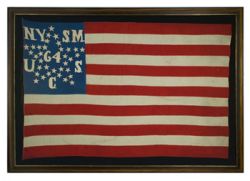
American flag waving may be a centuries-old tradition, but flag collecting - especially of those with unusual configurations or interesting variations - started hitting its stride in the last two decades.
And then came 9/11.
With patriotism at an all-time high, antique flags became a symbol of national unity. People remembered old flags stashed in their attics, bringing them into the light and onto the market.
That's around the time York antiques dealer Jeff R. Bridgman saw a big change, too, and he responded by doing more shows and increasing his advertising. The response was overwhelming.
"I was in flags before that, but when I started to push it, things really started to change," he said.
These days, historic flags and patriotic decorative arts are the focus of Bridgman's business. Not just on the Fourth of July, but year-round, he continues to see a significant increase in people wanting to collect flags. Banners from the Civil War - Union and Confederate - are in especially high demand as the country marks the 150th anniversary of that conflict.
Still, the beginning of the last decade was when historic flags' popularity took off, as important examples began to appear at shows and auctions. In 2002, the flag collection of Boleslaw and Marie-Louise D'Otrange Mastai sold at Sotheby's New York. (The Stars and Stripes: The American Flag as Art and as History From the Birth of the Republic to the Present, which records the collection, has become a major reference for collectors.)
And then Sotheby's struck gold in 2006 when it was offered the opportunity to sell four Revolutionary War flags - the last in private hands - taken as war trophies by the notorious British commander Lt. Col. Banastre Tarleton in 1779 and 1780.
One of the four, the flag of the Second Continental Light Dragoons of Connecticut, the first to feature 13 red and white stripes, brought $12.34 million, still a record not only for flags but for textiles, military, and Revolutionary War material. The other three sold as a group for a little more than $5 million.
What determines a flag's value? Experience certainly trumps appearance. That's why a tattered guidon - a swallow-tailed flag carried by cavalry troops - from the Battle of the Little Bighorn sold at Sotheby's in December for $2.2 million. The only flag not captured by the victors, the example was discovered under the body of a trooper by the burial party.
In addition to documentation, other qualities can raise or lower flag value. Bridgman lists visual impact, star configuration, age, and specific history. Condition - often the most important factor in pricing antiques - is much less important.
And Bridgman notes that size does matter: Many sewn flags in the 19th century were more than eight feet long, perfect for a public building but difficult to display in a home.
Collectors also may be interested in certain flags because they focus their acquisitions on a type - battle flags, parade flags, or flags with unusual variations in the field of stars or number of stripes. Of Bridgman's extensive inventory, his favorite is a flag of the 64th New York Volunteers. It's priced at $275,000.
"That is a 34-star flag, a presentation battle flag made for a Civil War unit that mustered in Elmira, N.Y.," he said. "The stars are configured in a star shape and there are letters intermingled that correspond to the unit's designation."
Bridgman also has the 1862 headquarters flag from Civil War Gen. Philip Henry Sheridan, priced at $550,000, with crossed swords, a star, and "No. 2" at the center, for the Second Michigan Cavalry.
Other collectors focus on political campaign flags, which were pre-20th-century banners that politicians used to advertise their candidacy. Bridgman has in stock the McKinley-Roosevelt and Bryan-Stevenson flags from their 1900 campaigns.
Interest by the general public in historic flag designs started during the Centennial celebrations of 1876, and the display of flags became a popular symbol of patriotism during the 20th century's World Wars.
Enthusiasm for historic examples began to grow in the 1990s. At that time, New Jersey collector J. Richard Pierce assembled a grouping of American parade flags, which were displayed at the 2007 Delaware Antiques Show and documented in the volume The Stars and Stripes: Fabric of the American Spirit.
In the book's introduction, Pierce wrote: "The Stars and Stripes rallies Americans in times of celebration as well as giving us the strength we need to carry on during times of peril. The flag is the symbol of our very foundation; it is the fabric that binds us together . . . it is the fabric of the American spirit."
| Jeff R. Bridgman Antiques, Inc • Historic York County, Pennsylvania • Tel. 717-502-1281 or 717-676-0545 • info@jeffbridgman.com All images and Text © Jeff Bridgman 2001 - 2021 |